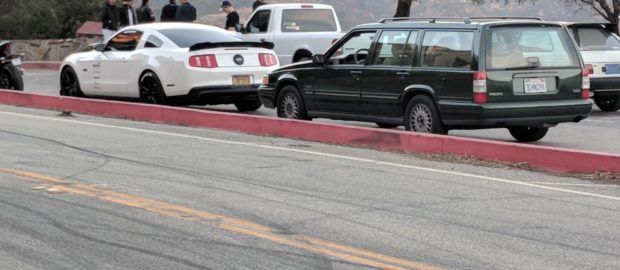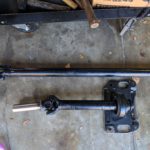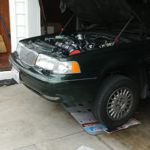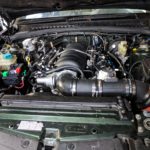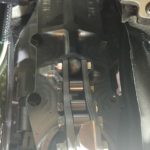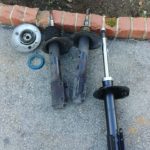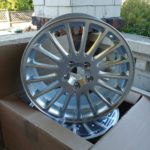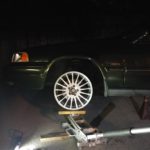As ambitious as we were to wrap up the Volvo project in a total of six months, that was overly optimistic in the scheme of things. After a series of setbacks, the green wagon is finally tearing up the streets…and its tires.
Last of the Puzzle Pieces
When we last left off, the Volvo still needed a driveshaft and the remainder of the wiring to be finished. The driveshaft ended up taking two attempts to get right, as the driveline shop forgot to shorten it on the first try. Two rush hour traffic jams later, the driveshaft was finally the correct length and ready to be installed into the car.
Theoretically the Volvo was ready to fire, but the Bruce-man wanted to have the exhaust fitted to the car to ensure the first start of the new engine didn’t throw any extra codes. With that in mind, the 960 was put on a flatbed headed to the exhaust shop.
As discussed before, the E-ROD comes with its own set of catalytic converters. To keep thing simple, the stock 960 muffler was retained, as supposedly it can handle the exhaust flow of the LS3. A custom midsection was welded up and the car was back in just two days.
- The driveshaft before it had actually been shortened.
- On jack stands at least once a week. There seems to be a theme with all of the cars…
- The engine almost ready for the first start.
- Off to the exhaust shop. This time the tow truck was a planned phone call.
Thinking we had all our ducks in a row, it was time to finally start the Camaro in disguise, but as luck would have it, no dice. After scratching our heads for a few days, the issue turned out to be poor voltage to the computer. The engine would crank but wouldn’t spark. With Bruce saving the day once more, the Volvo finally roared to life.
Break it in Before Breaking it
Having never installed an engine with zero miles on the clock, the concept of breaking in the LS3 was somewhat foreign…or domestic (bad joke, check). Using the supplied instructions, there were several steps that had to be taken before anyone could officially romp on 6.2 liters of pushrod glory.
The first part of the break-in process was to drive conservatively for 30 miles, then change the oil and filter. During this first oil change we learned of a slight issue with our oil pan selection. Turns out that the drain plug sits awfully close to the front subframe, so upon removal, the stream of burning has no clear path and splatters all over the place. Ouch and “I need a shower.”
Topped off with fresh oil, the next 500 miles were spent cycling through the revs up to 4000 RPM. A quick visit to the local Chevrolet dealer was done around this time to officially sync the ECU to the engine. By this point however, it was becoming very apparent that the suspension was tired and would need an overhaul. Unlike the earlier Volvo platforms (particularly the 240 and 740 based cars), the high offset, rear-wheel drive, IRS 960 suspension doesn’t have a lot of aftermarket support. Eventually Willum found Kaplhenke Racing, which carries a variety of trick Volvo suspension parts. A set of their Koni rear shocks were purchased, while the front end was simply refreshed with a set of OE Sachs struts, as we didn’t want to commit to coilovers just yet.
With the suspension more-or-less sorted, handling became more predictable and power could be put to the ground…until the all-season 195 tires would immediately spin in protest of their newfound duties. A while back we had purchased a set of 17×8 BBS RK wheels with the intent of installing wider rubber. Despite having what we thought to be a conservative offset of +35mm, they poked well beyond the 960’s slender waistband. Not the end of the world, but it was back to the drawing board.
In case there wasn’t enough going on already, the transmission decided to spring a leak. How did we spot this? One day sitting at a stoplight we noticed that the interior was drizzling automatic transmission fluid from the sun visor. Climate change may be a real phenomenon, but I can assure you there are no documented cases of water being converted into ATF during the precipitation process. Joking aside, the exposed transmission tunnel meant the seeping fluid was flinging off the driveshaft into the interior. Yours truly was quite upset that he had to spend the rest of that evening liberally applying a pre-wash stain remover onto one of his nicely ironed shirts. Fortunately there were no wardrobe casualties.
- Access is tight, but the shifter plate gasket needed to be replaced.
- After 23 years and 140k miles, the front struts were beyond trashed.
- The S60 17×7.5 “Tethys” wheels are our next attempt for new rolling stock. More OEM looking than the BBS wheels.
- Test fitting the wheels on the stock brakes, and looks like a small spacer is going to be necessary at minimum. Hopefully they clear the larger multi-piston calipers if that’s the route we choose.
It had turned out that the transmission was leaking from the shifter plate due to a faulty gasket. Apparently this is a common issue with the T56. Once the replacement parts were in hand, Billum applied a considerable amount of RTV to the gasket mating surface, and the Tremec has been leak free so far. Keep those fingers crossed.
Once the motor had finally broken in, it was decided that it would go through everybody’s favorite testing center: the California BAR Referee. On paper it should be a slam dunk, as the E-ROD comes with a CARB sticker, effectively making it a smog legal “bolt-on” part if you will. Truth be told, most smog shops won’t touch the car without being accompanied by the magic BAR sticker, so may as well get it over with. Testing went well, but the car failed on the first visit because there wasn’t proof of the motor having a stock tune. Back to the dealer for a fancy diagnostic printout, and the Volvo was tested yet again. This time around, it received the $8.25 sticker that lets the car roam the streets hassle-free.
Always Late to the Party
In the time it took to finish breaking in the LS3, I made the move to Southern California, so I hadn’t experienced the LS3 lifestyle over 4,000 RPM. About a month later, I get a call from Willum saying that he would be driving down that weekend, and the Bry-Man would simultaneously be flying into LAX from the upside-down land of Oz. Within fifteen minutes of getting home from work on Thursday evening, they were already at my door. We grabbed a quick bite to eat and decided we would meet up with our other high school chums. To get to their house meant I was put on taxi duties. Mistake.
On city streets the Volvo is quite easy to maneuver. It’s still the same old Volvo 960 aside from the tall Hurst shifter. I decided to hop on the freeway because that was the “quickest” route. Reality of the matter was I wanted to put the hammer down.
Thinking the 405 with lots of stop and go traffic was a good spot to unleash the beast, I was quickly reminded that a Volvo station wagon is not a precision instrument. Upon pedal to the metal action, the LS3 catapulted into warp drive by 5000 RPM and there was still 1300 RPM to go before the limiter. The sheer amount of torque means short shifting won’t cheat you of any frills. Should you choose to commit to redlining 2nd and 3rd gear, it’s almost certain the tail will get squirrely due to laughably small tires. In a sense it’s quite hilarious because 6.2 liters of madness are bellowing out the tailpipe of a 23-year-old green Volvo, but it becomes quite evident that the Swedes didn’t anticipate for all this speed.
Naturally we hit a traffic jam and I needed to slam on the brakes. Despite having new front struts, the 960 still had a considerable amount of nose dive, and the brakes didn’t seem to want to cooperate either. At 286mm in diameter and meant to stop 3500 lbs. with sub-200 horsepower stock, it’s safe to assume that more than double the horsepower and torque didn’t help the situation. Thankfully we were able to stop in time, but all three of us agreed there was no need for a repeat performance.
The next few days were spent tooling around town and cruising up to Malibu. I have to say the car performed great when driven like a model citizen. With time to spare, we drove up Mulholland and had the opportunity to confuse some locals as to why an old Volvo could scoot up the hills with such ease.
By the time the weekend was over, Will said he had clocked just over 1000 miles without the new engine skipping a beat, which may as well be a new record of reliability by our standards. There’s still plenty of items that will need attention. A brake upgrade is most definitely on the short list of things to do. One option is to keep the existing calipers and use larger 302mm Volvo rotors with a different OEM caliper bracket, while there are more costly options such as a Wilwood kit, or Brembo calipers adapted from other cars (plus the need for larger wheels to clear said brakes). Similarly, the suspension is still a topic of debate. There’s no doubt the front end needs to be stiffened up, but the only option we’ve been able to find is a set of custom JRZ coilovers, and they’re anything but reasonably priced.
On a positive note, the Volvo has been a success so far towards our goal of making a fun sleeper that can comfortably haul everyone and not leave us broken down and stranded…aside from that one time I blew off a radiator hose going uphill in 4th gear. Don’t worry though, as a Lyft driver brought us back to our tools while educating us on the mysterious world of cryptocurrency stocks.
- Just outside Santa Cruz on HWY 1 at some strange hour of the night.
- Parked at the “Snake” on Mulholland, perhaps looking like a fish out of water.
- A nice day, a nice view…and an old Volvo.
- Can’t forget that street parking permit!
Once the wagon is completely buttoned up, the goal is to make a serious road trip eastbound. You’d think with all the cool go-fast parts installed that the rest of the car would be in tip-top condition. Nope. The headliner is sagging, the electric seats are partially broken, and best of all, the heater core is disconnected because of a leak that requires complete disassembly of the dash, meaning there is plenty of work ahead of us. Also, I forgot to mention that the gauge readouts are displayed through a Bluetooth phone app. This is normally fine and dandy, that is until your Bumbler-gram power swipes start messaging you just as you need to check the RPMs and water temperature. Then again, you don’t want to keep those potential soulmates waiting…
–JC

